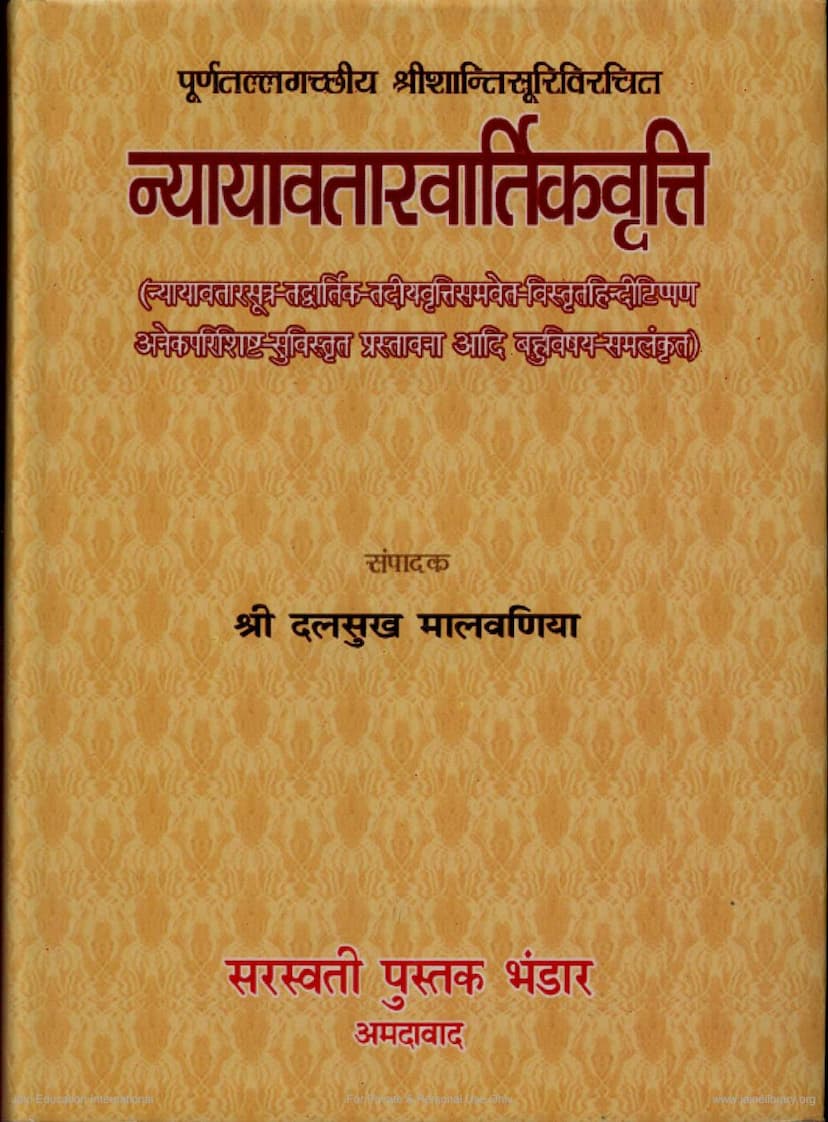Nyayavatarvartik Vrutti
Added to library: September 2, 2025

Summary
The provided text is a comprehensive summary of the Jain philosophical work "Nyāyāvatāravārtika-vṛtti" by Śrī Śānti Sūri, edited by Pandita Daḷasukha Malwaniya. The work is an extensive commentary on Siddhasena Divākara's "Nyāyāvatārasūtra" and Śāntyācārya's "Nyāyāvatāravārtika."
Here's a breakdown of the key aspects covered in the text, organized for clarity:
I. Introduction and Context:
- Title: Nyāyāvatāravārtika-vṛtti
- Author: Śrī Śānti Sūri (original commentary), Siddhasena Divākarasuri (original Nyāyāvatāra Sūtra), Śāntyācārya (Vārtika), edited by Pandita Daḷasukha Malwaniya.
- Publisher: Saraswati Pustak Bhandar, Ahmedabad.
- Series: Saraswati Oriental Research Sanskrit Series No. 14.
- Publication Details: First published 1949 (Singhi Jain Series No. 20), Reprint 2002.
- Content: Critically and authentically edited in Sanskrit, with an elaborate introduction, Hindi notes, indices, and appendices.
- Purpose: To provide a detailed and scholarly presentation of the Jain philosophical treatise.
II. Overview of Jain Philosophy (as presented in the introduction and indices):
The introduction and table of contents highlight the extensive coverage of core Jain philosophical concepts, including:
- Pramey-tattva (Reality/Objects of Knowledge):
- The nature of reality (dravya, guṇa, pṛyāya).
- Anekāntavāda (the doctrine of manifoldness/non-absolutism) as a central tenet, discussed in relation to its historical development, its relation to Vibhajyavāda (analytical doctrine), and its reconciliation with other philosophical schools.
- Syādvāda (the doctrine of conditional predication) and the Seven-Valued Logic (Saptabhaṅgī), including its historical context and the characteristics of its propositions.
- The nature of substances (dravya) and their relation to qualities (guṇa) and modes (paryāya).
- Detailed discussions on various substances like soul (jīva), non-soul (ajīva), matter (pudgala), space (ākāśa), time (kāla), and principles of motion (dharma) and rest (adharma).
- The concept of origination, decay, and permanence (utpāda-vyaya-dhrauvya).
- The indivisibility and permanence of the soul (jīva) and atoms (paramāṇu).
- The relationship between soul and body (jīva-śarīra).
- The nature of omniscient knowledge (sarvajña).
- Pramāṇa-tattva (Epistemology/Means of Knowledge):
- The Jain perspective on knowledge (jñāna), its discussion in the Āgamas, and its evolution.
- The relationship between knowledge and means of knowledge (pramāṇa).
- The classification of knowledge: Matijñāna (sensory/inferential knowledge), Śrutajñāna (scriptural knowledge), Avadhijñāna (clairvoyance), Manahparyāyajñāna (telepathy), and Kevalajñāna (omniscience).
- The distinction between direct (pratyakṣa) and indirect (parokṣa) knowledge.
- The debate on whether sensory knowledge (matijñāna) is direct or indirect.
- Detailed analysis of Inference (anumāna), its types, and its logical structure (hetu, sādhya, etc.).
- The role of Analogy (upamā) and Scripture/Testimony (āgama) as means of knowledge.
- Discussion on the validity of knowledge (prāmāṇya) and refutation of opposing views.
- Āgama-tattva (Scriptural Authority):
- The authority and nature of Jain scriptures (Āgamas).
- The importance and methodology of debate (vāda) and logical argumentation in Jain tradition.
- Discussion of various types of logical fallacies (chala, jāti, hetvābhāsa, vāda-doṣa).
- The relationship between Jain philosophy and broader Indian philosophical traditions, including Vedic thought (Vedānta) and Buddhism.
- Detailed discussions on the contributions of key figures like Bhagavan Mahāvīra, Pārśvanātha, and earlier thinkers.
- Naya-tattva (Standpoints/Methods of Interpretation):
- The concept of Naya (standpoints) and its various classifications (e.g., dravyārthika, paryāyārthika, śabdāśrita, arthāśrita, vyavahāra, niścaya).
- The role of Nayas in understanding the complex nature of reality and reconciling seemingly contradictory statements.
- The relationship between Naya and Pramāṇa.
- Specific Authors' Contributions:
- The work highlights the philosophical contributions of Siddhasena Divākara (founder of Nyāyāvatāra) and Śāntyācārya (commentator and author of the Vārtika).
- The editor, Daḷasukha Malwaniya, is recognized for his critical and authentic editing.
III. Key Philosophical Themes Discussed:
- Anekāntavāda and Syādvāda: The book delves deeply into these foundational Jain doctrines, explaining how they offer a non-contradictory way to understand reality, acknowledging multiple perspectives.
- Pramāṇa-Validity: A significant portion is dedicated to defining and defending the means of valid knowledge according to Jainism, particularly contrasting it with other Indian philosophical schools.
- The Nature of Reality: Discussions on dravya, guna, and pṛyāya, exploring how reality is simultaneously permanent (dravya) and changing (paryāya).
- Soul (Jīva): The nature, attributes, and liberation of the soul are extensively examined.
- Logic and Debate: The text likely contains detailed discussions on logical reasoning, fallacies, and the art of debate, as expected from a work on Nyāya (logic).
IV. Structure and Content of the Edition:
The "Nyāyāvatāravārtika-vṛtti" edition is described as being "decorated with a detailed introduction, notes, indices, appendices, and many subjects." This suggests a scholarly work that provides not only the primary texts but also extensive contextual and analytical material. The inclusion of "Vichār Kalikā" (a commentary) indicates a multi-layered analysis of the original sutras and the vārtika.
In essence, this work is a rigorous philosophical analysis of Jain logic and epistemology, tracing its roots in the Āgamas and presenting it in a structured, scholarly manner, with critical commentary and comparative insights into other Indian philosophical systems.